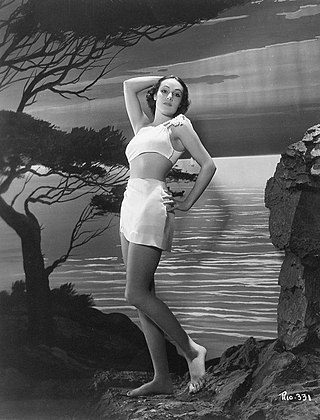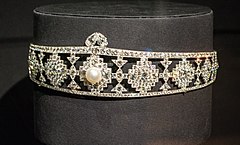
A bikini is a two-piece swimsuit primarily worn by girls and women that features one piece on top that covers the breasts, and a second piece on the bottom: the front covering the pelvis but usually exposing the navel, and the back generally covering the intergluteal cleft and a little, some, or all of the buttocks. The size of the top and bottom can vary, from bikinis that offer full coverage of the breasts, pelvis, and buttocks, to more revealing designs with a thong or G-string bottom that covers only the mons pubis, but exposes the buttocks, and a top that covers only the areolae. Bikini bottoms covering about half the buttocks may be described as "Brazilian-cut", while those covering about three-quarters of the buttocks may be described as "cheeky" or "cheeky-cut". In May 1946, Parisian fashion designer Jacques Heim released a two-piece swimsuit design that he named the Atome ('Atom') and advertised as "the smallest swimsuit in the world". Like swimsuits of the era, it covered the wearer's belly button, and it failed to attract much attention. Clothing designer Louis Réard introduced his new, smaller design in July. He named the swimsuit after the Bikini Atoll, where the first public test of a nuclear bomb had taken place four days before. His skimpy design was risqué, exposing the wearer's navel and much of her buttocks. No runway model would wear it, so he hired a nude dancer from the Casino de Paris named Micheline Bernardini to model it at a review of swimsuit fashions.

Lingerie is a category of primarily women's clothing including undergarments, sleepwear, and lightweight robes. The choice of the word is often motivated by an intention to imply that the garments are alluring, fashionable, or both. In a 2015 US survey, 75% of women reported having worn "sexy lingerie" in their lifetime.

A tube top, colloquially known in the UK as a boob tube, is a shoulderless, sleeveless women's garment that wraps around the upper torso. It is generally tight over the breasts, and usually uses elastic bands at its top and bottom to prevent it from falling. The tube top's precursor was a beachwear or informal summer garment worn by young girls in the 1950s that became more widely popular in the 1970s and returned to popularity in the 1990s and 2000s.

A nursing bra is a specialized brassiere that provides additional support to women who are lactating and permits comfortable breastfeeding without the need to remove the bra. This is accomplished by specially designed bra cups that include flaps which can be opened with one hand to expose the nipple. The flap is usually held closed with a simple clasp or hook.

In women's clothing, a corselet or corselette is a type of foundation garment, sharing elements of both bras and girdles. It extends from straps over the shoulders down the torso, and stops around the top of the legs. It may incorporate lace in front or in back. As an undergarment, a corselet can be open-style or panty-style.

A camisole is a sleeveless undershirt typically worn by women, extending to the waist. The camisole is usually made of satin, nylon, silk, or cotton.

A headband is a clothing accessory worn in the hair or around the forehead, usually to hold hair away from the face or eyes. Headbands generally consist of a loop of elastic material or a horseshoe-shaped piece of flexible plastic or metal. They come in assorted shapes and sizes and are used for both fashion and practical or utilitarian purposes.

A foundation garment is an undergarment designed to impermanently alter the wearer's body shape, to achieve what some view as a more fashionable figure. The function of a foundation garment is not to enhance a bodily feature but to make it look more presentable.

A chiton is a form of tunic that fastens at the shoulder, worn by men and women of ancient Greece and Rome. There are two forms of chiton: the Doric and the later Ionic. According to Herodotus, popular legend was that Athenian women began to wear the chiton as opposed to the peplos after several women stabbed a messenger to death with the bronze pins characteristic of the peplos.

The history of bras is closely tied to the social status of women, the evolution of fashion, and shifting views of the female body over time.
A back closure is a means for fastening a garment at the rear, such as with a zipper, hooks-and-eyes or buttons. Back closures were once common on Western female clothing, but have recently become less so, especially on female casual and business attire. They continue, however, to be widely used in underwear, formal wear and specialized clothing. Back closures are also common in garments for infants and toddlers.
A bra, short for brassiere or brassière, is a form-fitting undergarment that is primarily used to support and cover a woman's breasts. A typical bra consists of a chest band that wraps around the torso, supporting two breast cups that are held in place by shoulder straps. A bra usually fastens in the back, using a hook and eye fastener, although bras are available in a large range of styles and sizes, including front-fastening and backless designs. Some bras are designed for specific functions, such as nursing bras to facilitate breastfeeding or sports bras to minimize discomfort during exercise.

A training bra is a lightweight brassiere designed for girls who have begun to develop breasts, at Tanner stage II and III. The training bra is intended to be worn during puberty when the breasts are not yet large enough to fit a standard-sized bra. Training bras often provide minimal or no support, and may serve aesthetic purposes to fulfill cultural norms and local beauty standards.

Trousers, slacks, or pants are an item of clothing worn from the waist to anywhere between the knees and the ankles, covering both legs separately. In the United Kingdom, the word pants generally means underwear and not trousers. Shorts are similar to trousers, but with legs that come down only to around the area of the knee, higher or lower depending on the style of the garment. To distinguish them from shorts, trousers may be called "long trousers" in certain contexts such as school uniform, where tailored shorts may be called "short trousers" in the UK.

Underwear, underclothing, or undergarments are items of clothing worn beneath outer clothes, usually in direct contact with the skin, although they may comprise more than a single layer. They serve to keep outer clothing from being soiled or damaged by bodily excretions, to lessen the friction of outerwear against the skin, to shape the body, and to provide concealment or support for parts of it. In cold weather, long underwear is sometimes worn to provide additional warmth. Special types of undergarments have religious significance. Some items of clothing are designed as undergarments, while others, such as T-shirts and certain types of shorts, are appropriate both as underwear and outerwear. If made of suitable material or textile, some underwear can serve as nightwear or swimwear, and some undergarments are intended for sexual attraction or visual appeal.

Many stylistic variations of the bikini have been created. A regular bikini is a two-piece swimsuit that together covers the wearer's crotch, buttocks, and breasts. Some bikini designs cover larger portions of the wearer's body while other designs provide minimal coverage. Topless variants are still sometimes considered bikinis, although they are technically not a two-piece swimsuit.

Clothing in ancient Greece refers to clothing starting from the Aegean bronze age to the Hellenistic period. Clothing in ancient Greece included a wide variety of styles but primarily consisted of the chiton, peplos, himation, and chlamys. Ancient Greek civilians typically wore two pieces of clothing draped about the body: an undergarment and a cloak. The people of ancient Greece had many factors that determined what they wore and when they wore it.

Evidence of bikini-style women's clothing has been found as early as 5600 BC, and the history of the bikini can be traced back to that era. Illustrations of women wearing bikini-like garments during competitive athletic events in the Roman era have been found in several locations, the most famous of which is at Villa Romana del Casale.
Thousands of years of history provide evidence of the differing fashions, cultural norms, and artistic depictions regarding cleavage and clothes that accentuate or flaunt cleavage. From the absolute modesty of the 16th century, to the Merveilleuses Directoire dresses with their transparency, the décolleté has followed the times and is much more than a simple fashion effect.



















